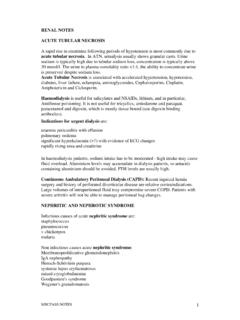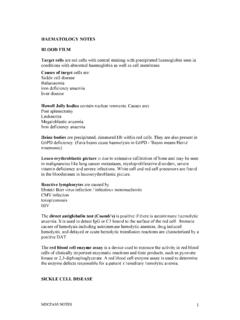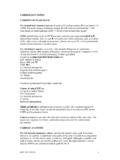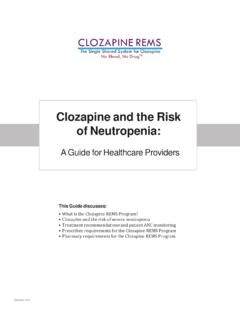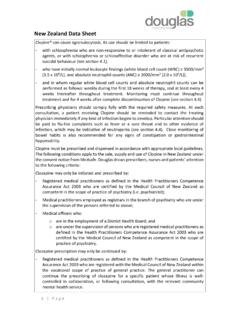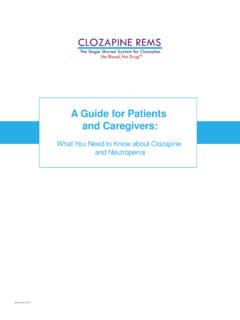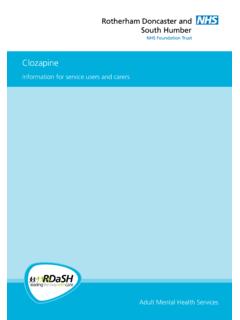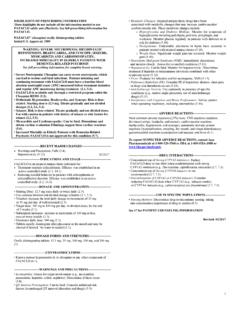Transcription of CLINICAL PHARMACOLOGY NOTES potent - …
1 CLINICAL PHARMACOLOGY NOTES Bioavailability refers to absorption of the drug. Increased gastric emptying and induction of liver enzymes increases first pass metabolism and reduced bioavailability. Potency refers to the amount of drug usually needed to produce an effect, such as relief of pain or reduction of blood pressure. For instance, if 5 milligrams of drug A relieves pain as effectively as 10 milligrams of drug B, drug A is twice as potent as drug B. Efficacy refers to the potential maximum therapeutic response that a drug can produce. Frusemide eliminates more salt than hydrochlorothiazide, hence it has higher efficacy than hydrochlorothiazide. The difference in speed of acetylation is due to the amount (or activity) of the enzyme N-acetyltransferase available. Fast acetylation is a trait which is autosomal dominant inherited. Drugs with zero order kinetics Alcohol Phenytoin Fluoxetine LIVER ENZYME INDUCERS (PCBRAS) Phenytoin Carbamazepine Barbiturates Rifampicin Alcohol Sulphonylureas LIVER ENZYME INHIBITORS (OAAK DEVICCES) Omeprazole Amiodarone Allopurinol Ketoconazole Disulfram Erythromycin Valproate Isoniazid Ciprofloxacin Cimetidine Ethanol Sulphonamides MRCPASS NOTES 1 Drug induced lupus: procainamide isoniazid chlorpromazine penicillamine sulfasalazine hydralazine methyldopa quinidine Drugs which can cause gynaecomastia are : digoxin oestrogens spironolactone cimetidine verapamil nifedipine Drugs causing galactorrhoea are: Oral contraceptive pills Phenothiazines such as chlorpropramide and thioridazine Metoclopramide Bromocriptine The drugs most commonly implicated in SIADH are: cyclophosphamide chlorpromamide carbamazepine clofibrate thiazide diuretics vincristine vinblastine phenothiazines tricyclic antidepressants SSRIs Drugs producing hypercalcemia include.
2 Lithium, alkaline antacids DES, Thiazides estrogens progesterone MISCELLANEOUS DRUGS MRCPASS NOTES 2 Common side effects of Selective Serotonin Reuptake Inhibitors (SSRIs) are nausea, vomiting, diarrhoea, appetite and weight loss, sexual dysfunction and deranged liver function tests. Similarly, the common side effects of fluoxetine are :anxiety or nervousness; decreased appetite; diarrhoea; drowsiness; headache; increased sweating; nausea; tiredness or weakness; trembling or shaking; insomnia. Amiodarone blocks conversion of T4 to T3 and affects pituitary thyroid axis. The following changes in thyroid function tests occur within 3 months of starting amiodarone and are not indicative of thyroid disease: increase in TSH up to 20mU/L increase in T4 to upper limit of normal decreased T3 levels. Anticholinergic syndrome occurs following overdose with drugs that have anticholinergic activity. Examples of these are tricyclic antidepressants, antihistamines and atropine.
3 Features include flushed skin, urinary retention, tachycardia, mydriasis (dilated pupils) and agitation. Physostigmine, a reversible inhibitor of acteylcholinesterase, is effective in treating anticholinergic symptoms but there is a significant risk of cardiac toxicity (bradycardia, AV conduction defects and asystole) with the drug. Bisphosphonates acts at the cellular level. They act directly or indirectly on the osteoclasts. The effect can be on the formation of osteoclasts and/or on their activity. A decrease in osteoclast number can occur either through direct action on osteoclast precursors, or indirectly by stimulating the osteoblasts to produce an inhibitor of osteoclast formation. Osteoclast inactivation is associated with bisphosphonate uptake from the bone surface. -interferon is a long term treatment (as opposed to steroids for acute relapses) which is of benefit only in the relapsing remitting form (about 40% of MS patients have this form), and slows progression of disability and reduces demyelinating lesions.
4 Aspirin toxicity causes symptoms of nausea, vomiting, headache, confusion and tinnitus or hearing difficulties. Major side effects of carbimazole are: agranulocytosis, thrombocytopaenia, acute hepatic necrosis, cholestatic hepatitis, lupus-like syndrome and vasculitis. It may cause neutropenia in 1 in 800 patients. Clozapine induced agranulocytosis occurs in about 1% to 10% of patient who take clozapine. Patients who have experienced agranulocytosis with prior treatment of clozapine should not receive clozapine again. Hyperkalaemia, hirsutism, tremors, hypertension, nausea and vomiting, headache, gum hypertrophy, parasthesiae and hypomagnesaemia are side effects of ciclosporin. MRCPASS NOTES 3 Disulfiram (antabuse) acts by causing raised acetaldehyde levels. This causes unpleasant effects. Metronidazole and disulfram synergism may lead to psychosis. Digoxin is slowly absorbed, hence peak effects can be delayed for up to half a day after an overdose. Visual disturbance, nausea and vomiting, tachy and bradyarrhythmias can occur with an overdose.
5 Activated charcoal decreases absorption. Etanercept is a dimeric fusion protein consisting of the extracellular ligand-binding portion of the tumor necrosis factor receptor (TNFR) linked to a human IgG1. The receptor binds to TNF, it is not a monoclonal antibody. It is licensed for juvenile rheumatoid arthritis and juvenile idiopathic arthritis. Side effects are septic arthritis, demyelination, pancytopenia, aplastic anaemia and congestive heart failure.. Infliximab is a monoclonal anti-TNF antibody. Ezetimibe acts by prevent cholesterol absorption from the small intestine. Typically it reduces LDL-cholesterol by approximately 20%, triglycerides by up to 5% and raises HDL-cholesterol by approximately 5%. Ezetimibe is currently licensed for use in combination with a statin in patients who fail to reach desired lipid profiles or as monotherapy in patients intolerant to a statin. Thiazides block Na+ and Cl- reabsorption in the distal tubule. There is usually passive Na+ and Cl- co transport.
6 With this blocked, natriuresis occur. The distal convoluted tubule accounts for 5% of total sodium chloride reabsorption. Thiazides elevate LDL cholesterol, reduce urinary calcium excretion and can cause impotence. Hypercalciuria can be treated with thiazides. Thiazides can cause thrombocytopaenia, hypokalaemia (blocking NaCl channels), and hyperuricaemia. Frusemide acts on the thick portion of the ascending loop of Henle. It inhibits Na+ and Cl- reabsorption there via Na+, K+, -ATPase-dependent pump. Owing to the large NaCl absorptive capacity of the loop of Henle, agents that act at this site produce a diuretic effect much greater than that seen with other diuretic groups. Insulin glargine is a long-acting insulin analogue, there is a smooth, prolonged absorption profile with no peaks. As such, it is a long-acting agent, suitable for providing a basal level of insulin which mimics the normal physiological state. Its smooth profile reduces the risk of hypoglycaemia, and when given at night, provides good control of the fasting blood glucose.
7 Lofexidine a centrally acting alpha-2 adrenergic agonist, was launched specifically for symptomatic relief in patients undergoing opiate withdrawal programmes. In open studies in small groups of methadone dependent patients, lofexidine treatment enabled successful detoxification (defined as remaining drug free for 10 days after the last methadone dose) in greater than 65% of patients. MRCPASS NOTES 4 Mesalazine can cause neutropenia . It works in IBD by release in the terminal ileum. Mesalazine is given in the acute attacks in Crohn's disease. Sulfasalazine (sulphapyridine and 5-amino-salicylic acid) is used in rheumatoid arthritis. Penicillamine is a DMARD which can is used in Rheumatoid arthritis, Juvenile chronic arthritis and as a copper binder in Wilson s hepatolenticular degeneration. It is also used in PBC, chronic active hepatitis and cystinuria. It can cause aplastic anaemia and thrombocytopenia, proteinuria and loss of taste. Penicillamine is associated with drug-induced lupus, Goodpasture s syndrome, myasthenia, myositis and Stevens-Johnson syndrome.
8 Orlistat is an inhibitor of gastrointestinal lipases, leading to reduced fat absorption. It is licensed for patients with BMI > 28 with associated risk factors, a weight management programme should be in place. Use is not recommended for more than 2 years. Quetiapine is indicated for the management of the manifestations of schizophrenia. The commonest side effects (>5%) are excessive sedation, dizziness, dry mouth, postural hypotension, and elevated ALT. Theophylline is metabolised in the liver. Plasma theophylline levels are increased in heart failure, cirrhosis of the liver, viral infections, elderly patients, and by drugs that inhibit metabolism of theophylline. The plasma levels of theophylline are decreased in smokers, chronic alcoholism and by drugs that induce liver metabolism. Metformin a biguanide. Its mode of action is thought to be multifactoral and includes delayed uptake of glucose from the intestinal tract, increased peripheral glucose utilisation mediated by increased insulin sensitivity and inhibition of increased hepatic and renal gluconeogenesis.
9 In metformin overdose, main symptoms of toxicity include gastrointestinal upset due to a severe lactic acidosis. Hypoglycaemia is not often seen in metformin overdose. If lactic acidosis occurs following overdose, mortality can be high. Management is gastric decontamination and use of activated charcoal if appropriate, and correction of acidosis with sodium bicarbonate. Haemodialysis can be considered in severe cases. Selective estrogen receptor modulators (SERMs) exhibit a pharmacologic profile characterized by estrogen agonist activity in some tissues with estrogen antagonist activity in other tissues. The first widely used SERM, tamoxifen, has estrogen antagonist activity in breast tissue but shows estrogen-like activity in other tissues. Raloxifene is another SERM in CLINICAL use, and it was developed to avoid some of the undesirable estrogen agonist actions of other SERMs to improve the drug safety profile. Raloxifene has been introduced for CLINICAL use in treatment and prevention of postmenopausal osteoporosis.
10 Sumatriptan is a 5HT1 agonist and may be useful in the treatment of acute migraine attacks. is available in injectable, intranasal, and oral formulations. Ergotamine tartrate is also effective in acute migraine. Propanolol, valproate, NSAIDs, MRCPASS NOTES 5amitriptyline, pizotifen and gabapentin are effective as prophylactic drugs in migraine. IMMUNOSUPPRESANTS Immunosuppresants: Corticosteroids act on cytosolic rather than cell membrane receptors. Both mycophenolate and azathioprine Approximately 1 in 300 Caucasians have thiopurine methyl transferase (TPMT) deficiency. TPMT is the enzyme that metabolises 6-mercaptopurine and its deficiency results in high risk of azathioprine toxicity. Azathioprine is used when steroid withdrawal causes recurrent relapse. Bone marrow suppression (low white cell count) and pancreatitis are side effects of azathioprine Methotrexate: Binding of methotrexate to dihydrofolate reductase reduces nucleotide synthesis as well as amino acids serine and methionine.
